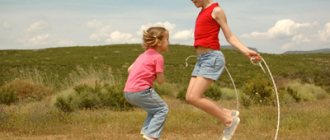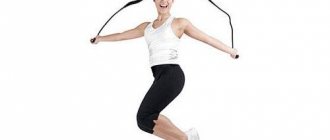Don't have time to visit the gym, but want to get in shape as soon as possible after giving birth? Or do you have financial problems to buy a home exercise machine, but don’t have enough energy for a morning run? There is an exit! Jumping rope is an inexpensive pleasure, but the benefits are invaluable!
Skipping is not only an effective exercise for all muscle groups. It is also a full-fledged sport. Jumping rope is also important for losing weight: it’s strength and cardio training in one bottle! A jump rope, a little space and endurance will allow you to lose several kilograms in a month if you do the training for fifteen minutes a day.
Is jumping rope beneficial?
Jumping rope is an exercise whose positive effect on the body is comparable to its simplicity and accessibility.
If you have understanding neighbors downstairs (or if they don’t exist at all), you can train indoors, if, of course, there is plenty of free space at home for unwinding the jump rope.
Regular training with a jump rope gives the following results:
- Charge of positive energy. A surge of emotions is guaranteed;
- Improved metabolism. During jumps, metabolism accelerates;
- Removing toxins. Sweat removes toxic substances from our body;
- Increased physical endurance. This result is achieved largely due to an increase in lung volume, which is provoked by the large amount of oxygen supplied during jumping rope;
- Toned body. During jumping, the hips, calves and abdominal muscles work. So slender legs and a beautiful waist are not such an unattainable effect from jumping rope.
The most important results of persistent training with a jump rope are calories burned and kilograms lost. However, it is not always easy to determine, even approximately, how many calories a jump rope burns.
Benefits of classes
Exercises with a jump rope have many advantages over other types of sports activity:
- training equipment is inexpensive and can be easily purchased at your nearest sports store;
- the jump rope does not require much storage space;
- You can practice in any convenient place;
- during jumping, muscle fibers are trained, cardiac activity is stabilized;
- the body's endurance increases significantly;
- the skin becomes more elastic, cellulite disappears.
However, before starting classes, you need to carefully study the contraindications. You cannot train with a jump rope in the following cases:
- pregnancy;
- recovery period after injuries;
- diseases of the musculoskeletal system;
- high blood pressure.
To achieve the effect you need to exercise regularly. Following the principles of proper nutrition will help you achieve the desired result faster.
What types of jump ropes are there?
The amount of calories burned is directly affected by the equipment used when jumping rope.
The more calories are burned the more difficult each jump is, or the more jumps are done per second. For the first case, a weighted jump rope is suitable, the weight of which increases due to weighting inserts or the use of heavier material when making the cord.
Be sure to read: What is shaping and how does it help you lose weight?
In addition, those who want to lose weight often choose high-speed jump ropes. The cord spins easier than on a regular jump rope, which makes you jump faster, burning more calories.
Leather jump ropes are a favorite equipment of boxers. Heavy handles combined with a light cord make it difficult to rotate the rope, adding stress to the exercise.
A correctly selected jump rope suitable for training purposes is already the key to success. But calorie consumption when jumping rope depends, of course, not only on the equipment.
Harm and contraindications
However, jumping rope does not bring only benefits to all athletes. Excessive exercise aimed at developing endurance can harm the cardiovascular system. We are talking about maximum and submaximal load. With this style of training, the heart rate exceeds all permissible values, and there can be no talk of any health benefits here.
Athletes with heart disease, for example, coronary heart disease, congenital or acquired defects, arrhythmia, arterial hypertension, should be especially careful.
For such diseases, the entire training schedule should be based on the recommendations of a specialist. Without proper supervision, you can easily harm your health, so be careful when using jumping rope.
In addition to people with problems with the cardiovascular system, jumping rope is not recommended for athletes who have somehow damaged the joints and ligaments of the knees, feet or ankles. For example, you should not lean on this exercise if you have had, for example, a sprained knee ligament or a fracture of the metatarsal bones - this is fraught with pain, and in some cases, a recurrence of the injury.
Active jumping is not recommended for athletes with varicose veins. In general, varicose veins are an occupational disease among gym goers. Often its source is the calf muscles. And the main load during jumping rope falls on them.
How many calories does jumping rope burn?
To create an individual training program with a jump rope that allows you to lose excess weight faster, you need to determine how many calories are burned when jumping.
Of course, jumping rope is the most effective type of cardio training, leaving swimming, aerobics and an exercise bike far behind. At the same time, the number of calories burned per unit of time will differ for each person.
This indicator depends not only on the intensity of the load and the regularity of the training itself, but also on “the initial data,” primarily weight:
- With a weight of 50-60 kg, 400-470 kcal are burned per hour;
- With a weight of 70-80 kg, 540-630 kcal per hour is burned;
- With a weight of 90 kg or more, 700 kcal per hour is burned.
It is noticeable here that the less a person weighs, the more difficult and longer it takes to burn calories when jumping rope. It is more difficult for the body to give away those calories that it really needs. An equally important factor influencing the number of calories burned is the number of jumps.
Advice from experienced coaches and athletes
There are 10 rules that will help make training with a skipping rope less traumatic for the joints and heart:
- You only need to jump in sneakers. This way you can avoid injury.
- Clothes should be tight-fitting and sporty. A woman should wear a top to support her breasts.
- The length of the rope must be chosen carefully. The handles should reach the armpits, no less and no more. For heights up to 160 centimeters, the jump rope should be 2.5 meters. From 160 to 175 between 2.6 and 2.8. From 176 to 180 between 2.9 and 3.0. For heights over 180 centimeters, more than three meters.
Rope length - Before jumping, you need to jog for five minutes, after training, also for five minutes. You should definitely do some stretching.
- You must not lean forward while jumping. Shoulders should be relaxed and down.
- You can't jump high. Jumping should be easy with slightly bent knees.
- Better less, but of better quality, than more, but violating the jumping technique.
- You should drink plenty of water during your workout. Otherwise, dehydration will occur.
- If a person has not been involved in sports before, or has health problems, he needs to consult a doctor before exercising.
- The first two or three days you need to jump for 5-10 minutes. If no health problems arise, you can continue training.
In the end, it is worth noting that jumping rope is a great way to lose extra pounds, because subcutaneous fat is wasted.
How many calories are burned by jumping rope 100 times?
100 jumps per day seems to be the generally accepted minimum. At least this many jumps must be done per day to see changes, but it is advisable to exceed this norm.
Professional athletes can easily do 150 jumps per minute, but an untrained adult will have to work harder to complete the same 100 jumps in 60 seconds.
The number of calories burned after 100 jumps is also calculated according to weight:
- With a weight of 50-60 kg, 6-8 kcal are burned;
- With a weight of 70-80 kg, 9-11 kcal are burned;
- If you weigh 90 kg or more, 12 kcal is burned.
100 jumping ropes seem to burn a few calories, although the same minute of walking only burns 3 kcal. In addition, it should be added that the next 100 jumps will increase energy costs, which means they will burn more calories.
Be sure to read: Effective exercises for weight loss with fitball
Why are calories needed?
Today there is a lot of talk about calories and how we need to get rid of them. They are in every product, as the inscription on the packaging clearly states. But what is a kilocalorie? Why should food be high in calories? How can you then get rid of extra calories?
Calories are a unit of energy. People, especially women, tend to think about food when they mention calories, but they are everywhere. For example, there are 7,750,000 calories in a liter of gasoline. The term refers to the amount of heat that is needed to heat one gram of water by one degree.
Important! 1 calorie is equal to 4.184 joules.
Physicists measure energy in joules. When people talk about the calories contained in foods, they think that there are 200 calories in a can of cola (as it says on the packaging). But what we really mean is the concept of kilocalorie (one kilocalorie is 1000 calories). It's just easier to talk about using the word calories. It turns out that there are 200,000 calories or 200 kilocalories in a can of cola. And there are 7,750 kcal in a liter of gasoline. The same approach applies to training, when they say that while jogging one kilometer, a person burned 75 calories, they mean 75 kcal.
During a one-kilometer run, a person burned 75 calories
The calorie content of the product must be calculated so as not to eat too much, but also not to remain hungry. Since calories are simply necessary for a person to breathe, move, and the heart to pump blood. Such energy comes only from food or is withdrawn from the body’s reserves, where it is stored in fat deposits. But due to the fear that there will not be enough reserves, the body turns to them only in the rarest cases.
The calorie content of food is determined by how many carbohydrates, proteins, which have 4 calories each, and fats, which have 9 calories, are in it. All food is divided into these three components. Knowing how much protein, fat and carbohydrates are in a product, you can calculate its calorie content. For example, on the packaging of oatmeal it is written that one hundred grams of the product contains 6 grams of fat, 12 grams of protein, 51 grams of carbohydrates. It turns out 306 kcal. This is exactly how much the body needs to complete metabolism, when carbohydrates are converted into sugars and glucose, fats become glycerol and acids, proteins turn into amino acids.
For normal life, the body needs a certain amount of calories. This is influenced by gender, age, physical activity, health, weight. On average, you need to consume at least 2000 kcal from food. If you consume more calories than you need, then you gain excess weight.
Every extra 7,000 calories is one kilogram of fat. If you consume less than the daily requirement of calories per day, then a person will lose weight, as the body uses fat reserves. Not only is fat burned during exercise, but the metabolism speeds up and the body can burn even more subcutaneous mass after exercise until all normal processes are restored. This usually takes two hours.
If we talk simply about calorie content, then it doesn’t really matter whether a person ate more fat or protein or carbohydrates. The main thing is to follow the rule: spend as much as you eat. Then there will be no excess weight, and the person will not lose weight either. But if we talk about the beauty of the figure and the slimness of the body, then what comes first is what you need to eat, for example, a cake or a piece of boiled chicken. Proteins are the builders of the body's cells, they nourish muscle mass, while fats are simply a source of energy. Therefore, it is important for a person to have a varied and healthy diet.
Important! It is impossible to completely avoid fats in food, since they help absorb vitamins.
How many calories are burned by jumping rope in 10 minutes?
I would like to burn 500 kcal every day. But for this you will have to jump rope for an hour. Those who are physically ready to withstand such a load face another problem - time. The modern rhythm of life does not always, and not for everyone, allow one to allocate an hour a day to work on the body. Busy people will hardly find 10-30 minutes. But even this time is enough to lose a couple of extra pounds.
Here's how many calories jumping rope burns during training:
- 38-45 kcal are burned in 5 minutes;
- 77-90 kcal are burned in 10 minutes;
- 115-135 kcal are burned in 15 minutes;
- In 20 minutes, 154-180 kcal are burned;
- In 30 minutes, 231-270 kcal are burned;
- In 60 minutes, 462-540 kcal are burned.
In addition to time, intensity, jump height, and pauses between jumps play a role.
The temperature of the place where the training takes place influences energy consumption during jumping rope. It is not difficult to guess that the number of calories lost increases if you exercise in hot conditions. But this does not mean that training should be done in a bathhouse.
Be sure to read: Yoga asanas for weight loss easy and relaxed
Who is not recommended to exercise with a skipping rope?
No matter how strange it may seem, jumping rope, just like any other type of physical activity, has some contraindications, in the presence of which this type of exercise must be abandoned. Let's list the cases when you should choose other methods as a method of burning calories.
- Problems with the spine or back.
- Cardiovascular diseases. These categories include hypertensive patients and people suffering from pressure changes.
- Having problems with connective tissue and cartilage
- Overweight.
It is also contraindicated to exercise with a skipping rope if you have just eaten a heavy meal. You need to start working 2 hours after eating.
Jump rope if you have the opportunity and have at least 10 minutes of free time. Gradually, you will see the effect of the training and you yourself will want and find the opportunity to jump for 30 or 40 minutes a day. Don’t forget to do jumping regularly and then you won’t be afraid of problems such as cellulite or excess weight.
What are the rules for jumping rope?
Jump rope, burn calories: it looks simple. But here, too, a number of features are revealed, without taking into account which, training becomes ineffective
- No exercise should be started without warming up, the same goes for jumping rope. A couple of simple turns, swings, and squats, familiar from school, will warm up the body and prevent unnecessary injuries.
- As you rotate the rope while jumping, your elbows and upper arms are pressed toward your body.
- When jumping, only rotate your wrist.
- Jumps are performed with a straight back and head raised slightly up.
- You don't have to eat too much before training. Indigestion is not the most desirable ending to classes. You should also abstain from water. It is better to quench your thirst after than before training.
- The pace of training should be increased gradually. You shouldn’t set yourself crazy goals, forcing your body to experience stress caused by an unexpected load.
- Stretching is a necessary completion of exercises. Stretching is an injury prevention, accelerating recovery and increasing training performance.
By following these recommendations, it’s easy to burn more calories from jumping rope.
Adapted, change tactics
Also, the amount of energy you expend will be influenced by your body’s adaptability to the exercise, or to the method of performing the exercise, to the training scheme itself. Our body is not able to distinguish whether you are jumping rope or simply jumping in place like a hare; it recognizes only the time of muscle tissue under load and the intensity of the load.
If you started at a slow pace and just adapted to working with the apparatus, prepared your ligaments and joints, and at the initial stage this gave you results, and you burned a lot of calories, then after a while you will need to complicate your training process. Gradually move from training to training to a new, more advanced level, you will accelerate your metabolism, and the number of calories burned will increase, and your dream of losing weight will be closer every day. To find out approximately how many calories you can burn by jumping rope, look at the tables below.
How to jump rope?
The correct technique for performing the exercise will help you burn even more calories when jumping rope.
For the first jump, the rope is placed behind your back. Then they spread their arms to the sides, pressing their elbows to the body. The lower part of the arms makes a circle. You need to throw the rope over yourself. At the moment when the cord reaches ankle level or slightly higher, they jump over it. It is important not to hit the rope every time on the floor and try to step over, but to scroll it, lowering it down enough so that you can jump over. The entire exercise is performed on tiptoes. During classic jumps, the legs are always closed and all actions are performed simultaneously.
It will not be easy for a beginner to immediately start jumping at a fast pace. In the first stages, it is better to slowly learn all the movements, feeling your body and the rope. All efforts will not be in vain; in the end, jumping rope will help you lose extra calories.
It’s not easy to get the figure of your dreams, but regular training with a skipping rope, which consumes a lot of calories, will bring you closer to your cherished goal.
Useful tips
Jumping rope, its benefits and harms have long been studied and all that remains is to find out how to properly train with it. It is recommended to do jumping jacks for a minute and then take a break for half a minute. This mode allows you not to overload the heart muscle and distribute blood evenly throughout the body.
To increase endurance, you can perform jumps on two legs, and then on each leg alternately. Double jumping ropes are effective for increasing muscle load and are recommended for athletes or people who are constantly training. You need to jump on the balls of your feet, with or without shoes, it does not affect the quality of the activity (as you wish). Clothes should be tight-fitting.
The state after performing jumps should be mildly tired and not cause discomfort or any pain. For general strengthening of the body, the duration of classes is 10-15 minutes daily, and for weight loss, jumping is performed for thirty minutes.
It is important to remember that the effectiveness of jumping depends on the regularity and intensity of training, as well as proper nutrition (eating vegetables and fruits in increased quantities) and daily routine. In case of any deviations from the normal state, taking into account sports loads, you should consult a doctor. Any workout is the key to a vigorous state and good mood.
Liked?! Share with your friends on social networks! Click the buttons below the article!
Participate in the competition and get 500 rubles.
Recommendations
1. At least three hours must pass after eating. It is permissible to jump only on an empty stomach.
2. Immediately after and before training, you should not drink liquid.
3. You should stop exercising if any discomfort occurs.
4. When jumping intensely, it is permissible to take short breaks of a few seconds. You will definitely need them to catch your breath, but you shouldn’t make them longer. Otherwise, the heart rate will drop significantly and this will negatively affect the lesson.
To fully burn calories, you should warm up before picking up a jump rope. It is aimed at warming up the muscles. Bends and squats are ideal.
After a preliminary warm-up, we begin jumping smoothly, gradually accelerating. Your back should be kept straight and your knees slightly bent. Landing should be on your toes. You can jump on both legs or on each leg alternately.
The height of each jump should not be high, ideally three centimeters. The strongest and most resilient can try to do a double jump with a double rotation. Jumping with a crossed rope is suitable for loading all muscle groups at the same time.
100 jumps away from perfection
H2_3
Let's start, perhaps, with the choice of a “tool of labor.” And the choice, believe me, is great. There are high-speed jump ropes that make more revolutions than regular ones; weighted, putting a lot of stress on the muscles of the arms and back; children's and even electronic ones with a built-in counter for revolutions and calorie expenditure. To fight cellulite and lose weight, there is no need for unnecessary bells and whistles; the most ordinary jump rope will do. But even among inexpensive models, it is important not to make a mistake and choose the ideal one.
OUR READERS RECOMMEND
How to choose a jump rope?
The optimal cable length is quite easy to determine. Fold the model you like in half and stretch your arms forward. The rope does not lie on the floor, does not dangle half a meter away from it, but barely touches the floor - this is your size.
You can use universal recommendations:
- If your height is no higher than 1.52 m, a length of 210 cm is recommended;
- Height 1.52-1.67 m – length 250 cm;
- Height 1.67-1.83 m – length 280 cm;
- Above 1.83 cm – length 310 cm.
Pay attention to what the cable is made of. Too light will not bring the desired result, the “simulator” will spin slowly and will not give a good load. Choose from polyvinyl, rubber or nylon models. The ideal cable thickness is 0.8-0.9 cm.
The correct handles are comfortable and noticeably heavy. They should not slip out of sweaty palms.
How to dress for training?
It would seem that at home you can jump in anything. Not so. It turns out that the form of clothing also affects the result. If you want to lose more weight, dress warmer. Together with sweat, another couple of hundred additional calories and excess fat cells that form cellulite will be burned. Have you decided to do without the sauna effect? Wear tight-fitting clothing that won't snag or snag you.
A sports bra for girls is a must. It will fix the breasts and protect them from stretch marks.
Do not jump in socks or barefoot. You can get injured in your knees, ankles or spine, because they bear the main load. Wear high-quality sports shoes that are springy and will absorb impacts. Bad shoes will lead to blisters and rapid fatigue.
When can I expect results?
When choosing jumping rope as a physical activity, you should not count on a sharp change in body weight. In order to notice the first shifts towards losing weight, you need to work hard and wait a little. Most often, beginners notice weight loss after 1-2 weeks.
Such success is achieved provided that a person trains three times a week for at least half an hour. Of course, there are times when after 2-3 sessions the scales show comforting numbers, or, conversely, almost a month of active work has passed, and only 1-2 kg have been lost. How do experts comment on such stories?
The problem here is the individual characteristics of the body. Therefore, before you throw away those kilograms that spoil your figure by jumping rope, get examined and make sure that impaired metabolism and other diseases do not prevent you from getting the maximum benefit from such activities.
Types of jumps
Here are some simple and effective exercises with a skipping rope that will help you lose weight.
“Flight” (allows you to spend 260-280 cal in 15 minutes). Stand up straight with a jump rope in your hands. Do 5 regular jumps, and after that 3 jumps with your legs tucked under you, as close to your hips as possible. Continue by performing 5 regular jumps again, etc.
“Soldier” (on average, burns about 250-260 cal in 15 minutes). Become as in the first exercise by performing 5 regular jumping ropes. After this, straighten and tense your entire body and thus do 10 more jumps. Alternate these types of jumps in a circle.
“Hip-hop” (allows you to burn about 230-240 calories in 15 minutes). The starting position remains unchanged. Perform 3 regular jumps, then “step” from foot to foot, using a jump rope and repeating the springing movements on your toes. Perform 10 such jumps, and then again 3 regular ones, etc.











